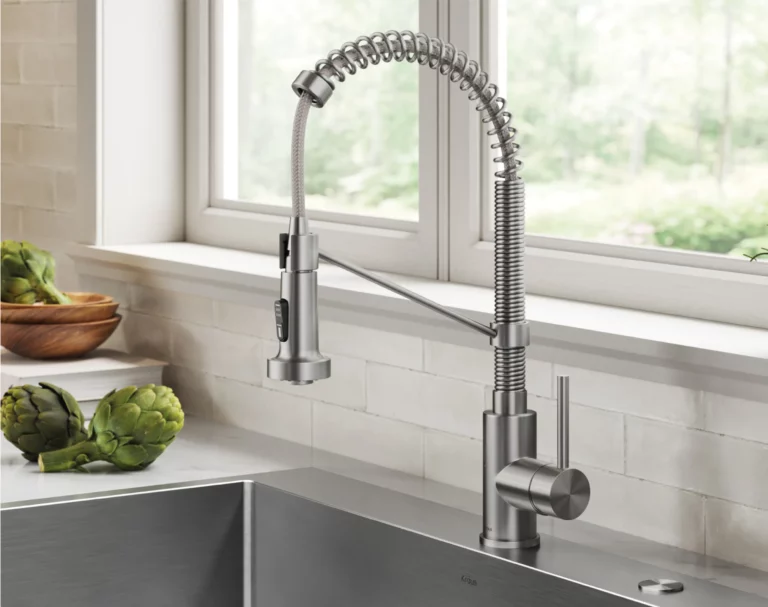GPM Shower Head Average: What You Need to Know
When it comes to shower heads, one important factor to consider is the GPM or gallons per minute flow rate. GPM is a measure of how many gallons of water flow out of the shower head each minute. The average GPM for a shower head in the United States is 2.5 gallons per minute.
However, it’s important to note that some states have regulations that require shower heads to have a lower flow rate. For example, WaterSense-labeled shower heads have a flow rate of 2 GPM. Additionally, some areas with water scarcity may have even lower GPM requirements. Understanding the GPM of your shower head can help you conserve water and potentially save money on your water bills.
Understanding GPM
As I researched shower heads, I came across the term GPM, which stands for Gallons Per Minute. GPM is an important factor to consider when choosing a shower head because it determines how much water flows out of the shower head per minute.
The average GPM for a shower head is 2.5. This means that 2.5 gallons of water flow out of the shower head every minute. However, some shower heads have a lower GPM, which means they use less water and are more water-efficient. On the other hand, some shower heads have a higher GPM, which means they use more water and may provide a more powerful shower experience.
It’s important to note that some states have regulations on the maximum GPM for shower heads. For example, California has a maximum GPM of 2.0 for shower heads. So, if you live in a state with regulations, make sure to choose a shower head that meets those regulations.
In addition to regulations, there are other factors that can affect the GPM of a shower head. For example, the water pressure in your home can affect the GPM of your shower head. If you have low water pressure, your shower head may have a lower GPM than it would with higher water pressure.
Overall, understanding GPM is an important part of choosing a shower head that meets your needs and preferences while also being water-efficient.
GPM Shower Head Average
When it comes to choosing a shower head, one of the most important factors to consider is the flow rate, which is measured in gallons per minute (GPM). The average GPM for a shower head is around 2, although this can vary depending on the state you live in.
For example, California has a maximum flow rate of 1.8 GPM, while some other states allow up to 2.5 GPM. It’s important to check your state’s regulations before purchasing a shower head to ensure it complies with the local laws.
A higher GPM shower head will provide more water flow and pressure, resulting in a more luxurious showering experience. However, it will also use more water, which could lead to higher water bills and may not be environmentally friendly.
On the other hand, a lower GPM shower head will save water and lower your monthly water bills. Ultra-low flow shower heads with a GPM of 1.5 or less are available for those who want to conserve as much water as possible.
Ultimately, the GPM shower head average is around 2, but it’s important to consider your personal preferences, as well as any local regulations, when choosing a shower head.
Factors Influencing GPM
When it comes to showerheads, the gallons per minute (GPM) is an important factor to consider. The GPM refers to the amount of water that flows through the showerhead in one minute. The average GPM for a showerhead is around 2.5, but there are several factors that can influence this number.
Showerhead Type
The type of showerhead you have can greatly influence the GPM. Some showerheads have a high flow rate, while others are designed to conserve water. For example, a rain showerhead may have a lower GPM than a traditional showerhead due to its wider coverage area. It’s important to consider the type of showerhead you want based on your water usage needs.
Water Pressure
Water pressure can also play a role in the GPM of your showerhead. If you have low water pressure, your showerhead may not be able to deliver the same amount of water as a showerhead with high water pressure. This can result in a lower GPM and a less satisfying shower experience. If you have low water pressure, you may want to consider installing a showerhead with a higher GPM to compensate.
Flow Restrictors
Many showerheads come with flow restrictors installed to help conserve water. These restrictors limit the amount of water that can flow through the showerhead, resulting in a lower GPM. While this can be beneficial for water conservation, it can also result in a less satisfying shower experience. If you want a higher GPM, you may want to consider removing the flow restrictor or purchasing a showerhead without one.
Regulations
Federal and state regulations can also influence the GPM of your showerhead. In 1992, the Energy Policy Act was passed, which mandated that showerheads have a maximum flow rate of 2.5 GPM. Some states, such as California, have even stricter regulations, limiting showerheads to a maximum flow rate of 2.0 GPM. It’s important to be aware of these regulations when purchasing a new showerhead to ensure compliance.
Overall, several factors can influence the GPM of your showerhead, including the type of showerhead, water pressure, flow restrictors, and regulations. It’s important to consider these factors when purchasing a new showerhead to ensure that you get the best shower experience possible while also conserving water.
Efficiency of Low GPM Shower Heads
As someone who is interested in reducing my water usage and saving money on my water bill, I decided to look into low GPM shower heads. After doing some research, I found that these shower heads can be a great way to save water and money without sacrificing the quality of my shower experience.
Low GPM shower heads typically use less than 2.5 gallons of water per minute (GPM), which is significantly less than the average shower head flow rate of 2.5 GPM. By using less water, these shower heads can help reduce your water usage and lower your water bill.
In addition to saving water and money, low GPM shower heads can also be more efficient than traditional shower heads. Because they use less water, they can help reduce the amount of energy needed to heat the water. This can help lower your energy bill and reduce your carbon footprint.
When choosing a low GPM shower head, it’s important to consider factors like water pressure and spray pattern to ensure that you get a shower head that meets your needs. Some low GPM shower heads may have a weaker spray than traditional shower heads, so it’s important to choose one that provides a comfortable and satisfying shower experience.
Overall, I have found that low GPM shower heads can be a great way to save water and money while still enjoying a satisfying shower experience. If you’re looking to reduce your water usage and lower your water bill, I would definitely recommend considering a low GPM shower head.
High GPM Shower Heads: Pros and Cons
If you’re someone who enjoys a strong, powerful shower, a high GPM (gallons per minute) shower head might be the right choice for you. But before you make a purchase, it’s important to understand the pros and cons of high GPM shower heads.
Pros of High GPM Shower Heads
- Strong water pressure: High GPM shower heads typically provide greater water pressure, resulting in a more vigorous showering experience.
- Large coverage: Some high GPM shower heads offer a wider surface area, which can provide a more immersive showering experience.
- Quick shower times: With a high GPM shower head, you can rinse off quicker and more efficiently, making for a more time-efficient shower.
Cons of High GPM Shower Heads
- Higher water bills: High GPM shower heads use more water, which can lead to higher water bills.
- Less water efficiency: With more water being used, high GPM shower heads are less water-efficient than low GPM shower heads.
- Environmental impact: Using more water can have a negative impact on the environment, especially in areas with water scarcity.
It’s important to weigh the pros and cons of high GPM shower heads before making a purchase. If you prioritize a strong, powerful shower and don’t mind paying a bit more for water usage, a high GPM shower head might be the right choice for you. However, if you want to conserve water and save on your water bills, a low GPM shower head might be a better option.
Regulations on Shower Head GPM
As a homeowner, it’s important to understand the regulations on shower head GPM (gallons per minute) to ensure the shower head you purchase meets the legal requirements. The federal government has set a maximum flow rate of 2.5 GPM for shower heads since 1994, which means that no shower head sold in the United States can exceed this limit.
However, some states and cities have set their own regulations that are more stringent than the federal standards. For example, California has a maximum flow rate of 2.0 GPM, while Colorado has a limit of 2.0 GPM for shower heads sold in the state, but allows up to 2.5 GPM for shower heads sold outside of Colorado.
It’s important to note that if your state, county, or city does not specify a maximum flow rate for shower heads, a 2.5 GPM shower head is the maximum that you can get.
To ensure that a shower head meets the legal requirements, look for the WaterSense label. WaterSense is a program sponsored by the Environmental Protection Agency (EPA) that promotes water efficiency and conservation. Shower heads that earn the WaterSense label must demonstrate that they use no more than 2.0 GPM. The WaterSense label also ensures that these products provide a satisfactory shower that is equal to or better than conventional shower heads on the market.
In summary, when purchasing a shower head, it’s important to check the regulations on shower head GPM in your state, county, or city to ensure that the shower head you buy meets the legal requirements. Look for the WaterSense label to ensure that the shower head is both water-efficient and effective.
How to Measure GPM of Your Shower Head
If you want to know how much water your shower head is using per minute, you can measure its GPM or gallons per minute. Here’s how you can do it:
- Get a bucket that can hold at least one gallon of water. You can use any container as long as you know its volume.
- Remove the shower head from the shower arm. You can use a wrench or pliers to unscrew it.
- Turn on the water to its maximum flow rate.
- Hold the bucket under the shower arm and let the water flow into it for exactly one minute.
- Turn off the water and measure the amount of water in the bucket.
- Divide the amount of water by the number of minutes you collected it. This will give you the GPM of your shower head.
If you got a result that exceeds the maximum flow rate allowed in your state or area, you may want to replace your shower head with a more efficient one. The federal standard for shower heads is 2.5 GPM, but some states and cities have lower limits. For example, California has a limit of 2.0 GPM, and Colorado and New York have a limit of 1.8 GPM.
By measuring the GPM of your shower head, you can determine how much water you’re using and find ways to save water and money. A low-flow shower head can help you reduce your water consumption without sacrificing your shower experience.
Impact of GPM on Water Bill
When it comes to choosing a showerhead, the gallons per minute (GPM) flow rate is an important factor to consider. A higher GPM rate means a more powerful shower, but it also means higher water usage. This can have a significant impact on your water bill each month.
According to the Environmental Protection Agency (EPA), the average American household uses around 300 gallons of water per day. Showers alone account for approximately 17% of that total, which can add up quickly. By choosing a showerhead with a lower GPM rate, you can significantly reduce your water usage and ultimately save money on your monthly water bill.
For example, if you currently use a showerhead with a 2.5 GPM rate and switch to a 1.5 GPM showerhead, you could potentially save up to 10,000 gallons of water per year. This translates to a savings of approximately $100 on your annual water bill.
It’s important to note that some areas have regulations in place regarding maximum GPM rates for showerheads. For example, California, Colorado, and New York have a maximum flow rate of 2.0 GPM. Be sure to check with your local water authority to ensure that you are in compliance with any regulations.
In addition to saving money on your water bill, choosing a showerhead with a lower GPM rate can also have a positive impact on the environment. By reducing your water usage, you are helping to conserve this precious resource for future generations.
Conclusion
After researching and analyzing the information available on shower head GPM, it’s clear that the average flow rate for shower heads is 2.5 GPM. However, it’s important to note that some states have regulations that require even lower GPM rates, such as WaterSense-labeled shower heads with a flow rate of 2 GPM.
It’s also worth noting that the GPM rate can vary depending on the type of shower head you have. For example, low-flow shower heads typically have a GPM rate of 1.5 or lower, while high-pressure shower heads can have a GPM rate of 2.5 or higher.
When it comes to choosing a shower head, it’s important to consider your personal preferences and needs. If you’re looking to conserve water and save on your water bill, a low-flow shower head may be the best option for you. On the other hand, if you prefer a powerful and invigorating shower experience, a high-pressure shower head may be more suitable.
Ultimately, the decision on which shower head to choose comes down to personal preference and individual circumstances. By understanding the importance of GPM rates and the different types of shower heads available, you can make an informed decision that meets your needs and helps conserve water.





